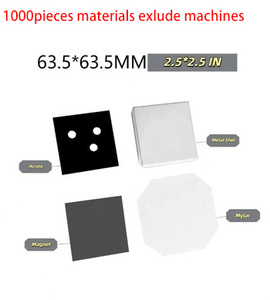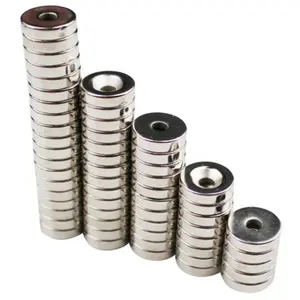
All categories
Featured selections
Trade Assurance
Buyer Central
Help Center
Get the app
Become a supplier

(117 products available)



















































The manufacturing process of magnets needs specific types of machines for each crucial stage. Here's a list of the essential types of the neodymium magnet making machine:
Pulverizing mill
Pulverizing mills break down the magnet material into a fine powder. Different types of mills perform this task, including jet, hammer, and ball mills. The selection depends upon the required particle size and shape distribution for the NdFeB magnet.
Pressing machine
The pressing machine helps create a solid mass of the magnet by compacting the magnet powder. The machine utilizes high pressure and controlled temperatures to achieve dense magnet blocks with determined shapes and sizes.
Sintering furnace
The sintering furnaces help magnet densification and bond formation by heating the compacted magnet material. These automated heating units maintain temperature programs that allow the material to develop its unique properties.
Machining center
Machining centers cut and grind the sintered NdFeB magnets to achieve the desired shape, size, and tolerance. These devices utilize CNC technology for precise control over the machining process. They are multifunctional and easy to use.
Coating machine
Coating machines protect the NdFeB magnets from corrosion and environmental damage. They apply various types of coatings, such as epoxy, nickel-copper-nickel, or zinc. The choice of coating and the application method can vary depending on the magnet's specific end-use requirements.
Assembly line
Neodymium magnets are assembled into more complex magnetic systems or products using the assembly line. Automated systems for insertion, bonding, fastening, and other techniques help create finished products that comply with predetermined standards and specifications.
Quality control machines
Neodymium magnet making machines also include different quality control devices that monitor each production stage and perform tests on resulting products. They can identify defects, ensure proper magnetization, and verify that coating quality is up to par. Using these devices improves the quality of the final product and boosts efficiency by lowering magnet waste.
Neodymium magnet making machine presents different specifications depending on the types and models available. Some crucial specifications are:
Production Capacity
The neodymium magnet-making machine's production capacity is often expressed in numbered pieces per hour or day. This shows how many magnets the machine can produce within a given time frame.
Working Pressure
The working pressure or falling pressure of a neodymium magnet-making machine is measured in pascals (Pa), which is used to show the pressure that the machine can use to cause magnetization in the neodymium material during production.
Power
Power is often expressed in kilowatts (kw). The power determines the machine's energy consumption and operating performance.
Dimension
The dimension of the machine is often expressed as millimeters (mm) and counts like length, width, and height. The dimension indicates the space and volume of the Neodymium magnet-making machine, which determines how to integrate and utilize it in the production line.
Weight
Weight: Weight of the machines affects the handling and locating aspects. It is expressed in tons or kilograms (kg) as it is a heavy industrial equipment.
Automation
Automation: The degree of automation of a neodymium magnet-making machine can influence its operation and control. Such can be included as automated equipment with automatic control and detection function or as a semi-automated equipment that needs manual operation and assembly.
For durability and optimal performance, neodymium magnet-making machines require maintenance. The following are some essential maintenance tips for these machines:
Neodymium magnet machines can manufacture countless products from iron, boron, and neodymium mix elements. There are limitless possibilities for products that need NdFeB magnets in most industrial and retail sectors.
In the machinery industry, some machines use the neodymium magnet as a coupling for magnetic drive pumps. Magnetic drive pumps are frictionless, easy to maintain, and reliable. They are ideal for transferring fluids in the chemical processing, power generation, and oil and gas industries, among others.
In the automotive industry, many applications utilize neodymium magnets—inventory door locks, speakers, sensors, and brushless DC motors. Brushless DC motors are popular in electric and hybrid vehicles because of their high performance. The motor's rotor uses a permanent magnet that comprises neodymium magnets.
Some domestic applications of the NdFeB magnet include the refrigerator door, where magnets help keep the door closed and seal it properly to maintain the temperature inside. Other home benefits include holding cabinets and drawers in place, closet doors, and electric toothbrushes. The neodymium magnet toothbrush uses no wires and provides inequity safe and gentle cleaning.
Marketing and advertising companies use neodymium magnets in different ways. Car wrapping companies utilize them for their easy-to-remove car ads. Businesses can easily remove the car magnets when they need to change their advertisement or when the promotional period is over.
Another application in the advertising industry is in refrigerator magnets, which are one of the most common advertising tools used globally. The small-sized advertising magnets are made using neodymium magnets because they are small and powerful, providing the necessary holding force.
Another unique application using neodymium magnets is the maglev train. It uses them in its suspension system to levitate above the track. The magnet train system offers a smooth and fast ride, and in some cases, the trains can reach speeds of up to 600km/h. There are no obstacles between the train and the track, making the friction very low.
When selecting an NdFeB magnet manufacturing machine, several key factors should be taken into consideration to ensure that the machine chosen will meet production demands.
Material compatibility
The machine should be compatible with the specific types of rare-earth metal powders that will be used. Different types of powder have distinct processing requirements, so it's crucial to ensure the machine can handle the chosen material.
Production capacity
Consider the production volume that the machine needs to be able to handle. The capacity of the machine should align with production demands to ensure it can meet output requirements.
Technology and features
Different machines offer various technologies and features that can impact magnet quality and production efficiency. Research the advantages of different machines to determine which technologies would be most beneficial for the intended application.
Quality and reliability
Select a machine manufacturer with a proven reputation for high-quality, reliable equipment. The durability and dependability of the manufacturing machine are critical for ongoing production success.
After-sales service
Consider the after-sales support provided by the machine manufacturer. Ensure they offer technical support, spare parts availability, and maintenance services to address any issues that may arise after the machine is purchased.
Q1 What are the latest advancements in neodymium magnet making technology?
A1 The latest advancements in neodymium magnet making machines focus on improving production efficiency, magnet performance, and environmentally friendly practices. For example, modern magnet manufacturing machines use automated systems, computer numerical control (CNC) technology, and laser cutting and welding techniques to enhance precision and reduce manufacturing time.
Q2 What are the trends in neodymium magnet making machines?
A2 The trend toward customization is increasing as more industries adopt neodymium magnets for various applications. Additionally, environmentally friendly practices are being adopted by the magnet manufacturing industry, such as recovering and recycling rare earth materials from leftover production residues.
Q3 Can buyers get a neodymium magnet-making machine kit?
A3 Yes, buyers can buy a neodymium magnet-making machine kit or assemble the individual components. It is better to buy the individual components if cost is a major concern or to order specified customizations. Talk to an expert to see if this is a viable option for the intended production line.
Q4 What accessories are compatible with the neodymium magnet making machine?
A4 Accessories that are typically compatible with the neodymium magnet-making machine include gratings, refrigerator clips, ceramic magnets, magnetic sheets, and flexible magnets. Custom accessories can be made upon request.
Q5 Are neodymium magnet-making machines safe?
A5 Yes, when used according to the manufacturer's instructions, neodymium magnet-making machines are safe. Neodymium magnets are extremely powerful and can pinch skin and body parts. Operators should always use protective gear and be trained as instructed.